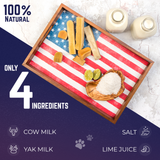Key Takeaways
- Dehydrated chicken dog treats are made by slowly removing moisture from fresh chicken at low temperatures.
- This method preserves the nutrients while creating a shelf-stable and preservative-free treat.
- These treats are single-ingredient and rich in protein.
- They are safer than rawhide and more digestible than processed alternatives.
Table of Contents
- Why Dehydrated Chicken Dog Treats Belong in Your Pack
- Understanding Dehydration, How "Less is More" Unleashes Better Treats
- Selecting the Best Chicken Cuts and Quality for Dehydrating
- Step-by-Step – How to Make Dehydrated Chicken Dog Treats at Home
- Safety & Storage, Keeping Treats Fresh, Safe, and Shelf-Stable
- Serving & Training Applications, How (and How Much) to Treat Your Dog
- Troubleshooting & Pro-Level Tips, Solving Your Jerky Woes
- Dehydrated Chicken Dog Treats vs. Other Dog Chews, Full Comparison
- Take the Lead – Responsible Treat Choices & Devil Dog Pet Co. Promise
- FAQs – Dehydrated Chicken Dog Treats
- Advanced Applications and Future Considerations
- Final Verdict: When Homemade Wins and When to Upgrade
Dehydrated Chicken Dog Treats – Extreme Dog Leadership
Why Dehydrated Chicken Dog Treats Belong in Your Pack
Real leaders don't settle for mystery-ingredient garbage. Dehydrated chicken dog treats deliver pure protein power, typically 80-85% protein with less than 5% fat, making them ideal fuel for working dogs, active breeds, and training-intensive sessions. Unlike processed treats loaded with fillers and preservatives, these single-ingredient chews give you complete control over what enters your dog's system.
The jerky-style texture satisfies natural chewing urges while remaining gentle on teeth, unlike brittle biscuits or dangerous rawhide. Each strip provides 15-30 calories of concentrated nutrition, perfect for reward-based training without derailing daily meal plans. For sensitive stomachs or elimination diets, nothing beats the transparency of one ingredient: chicken.
For dogs that need longer-lasting options, antler dog chews and braided bully sticks can provide extended chewing satisfaction while still supporting your dog's natural instincts.
Nutritional Advantage
- Protein: 80-85% (vs. 12-20% in typical soft treats)
- Fat: 3-5% (vs. 8-15% in commercial jerky treats)
- Ingredients: 1 (vs. 15-30 in processed alternatives)
- Shelf life: 2 weeks refrigerated, 6 months frozen
Understanding Dehydration, How "Less is More" Unleashes Better Treats

Dehydration removes 85-90% of moisture at controlled low heat, preventing bacterial growth while preserving amino acids that high-temperature baking destroys. This process concentrates flavor naturally, no artificial enhancers needed, while creating the chewy texture dogs crave for extended gnawing sessions.
Unlike freeze-drying, which creates crumbly textures that disappear in minutes, properly dehydrated chicken maintains structural integrity for 20-45 minute chew sessions. The controlled moisture removal also eliminates the need for chemical preservatives, giving you a clean ingredient list your vet will approve.
If you're curious about the differences between dehydration and freeze-drying, you can learn more in this guide to freeze dried chicken dog treats.
Selecting the Best Chicken Cuts and Quality for Dehydrating
Lean, boneless, skinless breast meat delivers maximum protein with minimal spoilage risk. Avoid dark meat, higher fat content reduces shelf life and increases rancidity potential. Source organic or antibiotic-free chicken when possible, always checking labels for added solutions or sodium injections that compromise the single-ingredient promise.
Fresh chicken with less than 1% retained water and under 100mg sodium per serving provides the cleanest foundation. Buy in bulk, portion into weekly prep sizes, and freeze unused portions. Quality starts at sourcing, grocery store "enhanced" chicken with 15% added solution creates inferior, sodium-loaded treats.
Step-by-Step – How to Make Dehydrated Chicken Dog Treats at Home
Partially freeze chicken breasts for 1-1.5 hours, this firms the meat for uniform ¼-inch slicing. Cut with the grain for tough, long-lasting jerky ideal for power chewers, or across the grain for tender pieces perfect for training rewards. Pat each strip dry and trim all visible fat, fat equals faster spoilage.
Pre-cook chicken to 165°F internal temperature for USDA safety compliance. For dehydrator method, arrange strips in single layers at 145-165°F for 8-12 hours, checking at 6 hours for "bend but not snap" texture. Oven users should set 250-275°F, place strips on wire racks over rimmed trays, and bake 2-3 hours, flipping halfway through.
Marine-Tested Tip: Always cool strips completely before storage. Sealing warm treats traps moisture, creating perfect mold conditions. Test doneness by breaking a strip, interior should show no moisture or soft spots.
Safety & Storage, Keeping Treats Fresh, Safe, and Shelf-Stable

Room temperature storage in airtight containers extends freshness up to 7 days; refrigeration pushes this to 2 weeks. For maximum shelf life, freeze portions in labeled, dated bags for 3-6 months. Glass jars with tight seals or vacuum-sealed pouches provide optimal protection against moisture and contamination.
Watch for spoilage indicators: greasy residue, surface moisture, sour odors, or visible mold. When in doubt, discard immediately. The "cool completely before sealing" rule cannot be overstated, trapped heat creates condensation that breeds dangerous bacteria within hours.
Serving & Training Applications, How (and How Much) to Treat Your Dog
Standard serving guidelines: 1-2 strips daily for 40-70 pound dogs, half strips for smaller breeds. Break into pea-sized pieces for training rewards, dehydrated chicken dog treats maintain structural integrity better than soft alternatives, providing consistent motivation during extended sessions.
Insert whole strips into puzzle toys or Kong stuffers for mental enrichment during crate time. Balance treat calories (15-30 per strip) against daily meal portions, treats should enhance nutrition, not replace balanced meals. For dogs on elimination diets or chronic GI issues, consult your veterinarian before introducing any new treats, including homemade dehydrated chicken.
Troubleshooting & Pro-Level Tips, Solving Your Jerky Woes
Most homemade treat failures stem from three critical errors: inadequate moisture removal, improper storage, and wrong slice thickness for your dog's chew style. Moldy treats indicate trapped moisture, always cool strips completely before sealing and trim every visible fat streak before dehydrating. Fat turns rancid fast and creates the perfect breeding ground for bacteria.
Overly tough or sharp-edged treats signal overbaking or cutting with the grain for small chewers. Slice thinner strips across the grain for puppies and seniors, and reduce dehydrating time by 1-2 hours. If your dog shows zero interest, warm a strip for 10 seconds to release aroma, or marinate briefly in low-sodium bone broth before the next dehydrating session.
Quick Troubleshooting Reference
- Solution: Slice thinner, extend dehydrating time, ensure complete cooling before storage
- Solution: Warm briefly to release scent, try marinating in bone broth, or slice smaller for training rewards
For more tips on healthy snacking and ingredient transparency, check out this comprehensive guide to single ingredient dog treats.
Dehydrated Chicken Dog Treats vs. Other Dog Chews, Full Comparison

Understanding where dehydrated chicken dog treats fit in your leadership arsenal requires honest comparison against proven alternatives. Homemade chicken jerky excels as low-calorie training rewards and quick flavor hits, but lacks the dental scraping power and marathon chew time that heavy-duty options deliver.
For power chewers and serious dental maintenance, elk antler chews and yak cheese sticks provide superior jaw exercise and plaque removal. Devil Dog Pet Co.'s naturally shed elk antlers last weeks longer than any homemade treat while delivering essential minerals. However, dehydrated chicken treats offer unmatched ingredient control, you know exactly what goes into every batch.
| Chew Type | Protein Content | Chew Duration | Dental Benefits | Ingredient Control | Best For |
|---|---|---|---|---|---|
| Dehydrated Chicken | 80-85% | 5-15 minutes | Minimal | Complete | Training, sensitive stomachs |
| Elk Antler Chews | 45-50% | 3-5 weeks | Excellent | Natural single-source | Power chewers, dental health |
| Yak Cheese Chews | 65-70% | 1-2 weeks | Good | Minimal ingredients | Moderate chewers, flavor motivation |
| Bully Sticks | 75-80% | 20-60 minutes | Good | Single ingredient | Digestible long-term chewing |
Take the Lead – Responsible Treat Choices & Devil Dog Pet Co. Promise
Real leadership means owning every choice, from treat quality to daily discipline. Making your own dehydrated chicken dog treats demonstrates commitment to understanding exactly what fuels your dog's performance. But leadership also means recognizing when professional-grade options deliver superior results with less risk.
For training rewards and dietary control, homemade dehydrated chicken treats earn their place in your pack. For serious dental maintenance and marathon chewing sessions, Devil Dog Pet Co.'s naturally shed elk antlers and traditional yak cheese chews provide the durability and mineral content that homemade options simply cannot match. Want premium chews without the guesswork? Discover our all-natural, protein-packed reward line, always single-ingredient, always extreme-leadership approved. Your dog's success starts with the choices you make today.
FAQs – Dehydrated Chicken Dog Treats
Are dehydrated chicken dog treats safe for all breeds and ages?
Quick Answer: Yes, for dogs over 12 weeks with adult teeth. Always supervise and adjust piece size, break into pea-sized bits for toy breeds, whole strips for large dogs.
How long do homemade dehydrated chicken dog treats last?
Room temperature in airtight containers: 7 days. Refrigerated: 2 weeks. Frozen: 3-6 months. Always label batches with prep dates and discard at first sign of greasiness or off-odors.
Are dehydrated chicken treats good for dogs with allergies?
Excellent for beef, lamb, or grain allergies since pure chicken contains only one protein source. However, dogs with poultry allergies should avoid entirely. Always introduce new proteins gradually over 3-5 days.
Can dehydrated treats promote dental health?
Minimal dental benefits compared to elk antlers or yak chews. The jerky texture provides light gum massage but lacks the scraping action needed for serious plaque removal. Use primarily for training rewards, not dental maintenance.
What are the choking hazards and how do I prevent them?
Small dogs can choke on whole strips; large dogs may gulp pieces too quickly. Prevention: slice appropriately for your dog's mouth size, supervise all chewing, and remove any pieces smaller than a quarter.
Can you travel with dehydrated chicken treats?
Perfect travel companions, no refrigeration needed for up to 7 days, TSA-friendly, and won't leak in luggage. Pack in sealed containers and bring only what you'll use to avoid spoilage in varying temperatures.
What's the nutritional breakdown of homemade dehydrated chicken?
Approximately 80-85% protein, 8-12% fat, 300-350 calories per 100g. One medium strip (5g) contains roughly 15-18 calories, ideal for training without disrupting meal balance.
Do preservative-free dehydrated treats have added risks?
Higher spoilage risk requires stricter storage discipline. Benefits outweigh risks when you follow proper cooling, sealing, and dating protocols. Commercial preservatives extend shelf life but aren't necessary with correct handling.
Are dehydrated chicken treats considered "raw" or "cooked"?
Cooked. Proper dehydration requires pre-cooking chicken to 165°F internal temperature for USDA safety standards, then removing moisture through controlled heat. The finished product is shelf-stable cooked protein.
For more information on pet food safety and regulations, visit the FDA's pet food resource.
Advanced Applications and Future Considerations

Experienced dog leaders discover that dehydrated chicken dog treats serve as foundation blocks for more sophisticated training protocols. Combine small chicken pieces with high-value rewards like elk antler shavings or yak cheese dust to create variable reward schedules that maintain engagement during complex behavior shaping. This layered approach prevents treat predictability while controlling caloric intake.
Consider seasonal batch preparation strategies that align with your dog's changing activity levels. Summer months demand leaner, smaller portions for heat-stressed dogs, while winter training intensifies require protein-dense strips that fuel extended outdoor sessions. Smart leaders prep quarterly batches, vacuum-seal monthly portions, and rotate protein sources to prevent dietary boredom.
The future of homemade dog treats lies in precision nutrition, tracking your dog's response to different cut thicknesses, dehydration times, and serving frequencies. Document which preparations generate the strongest training motivation and longest-lasting engagement. This data becomes invaluable when scaling up for multi-dog households or transitioning between life stages from puppy energy to senior maintenance needs.
To explore more about the science behind dehydration, see this overview of food dehydration.
Final Verdict: When Homemade Wins and When to Upgrade
Dehydrated chicken dog treats excel in three specific scenarios: dietary elimination protocols requiring single-protein sources, high-frequency training sessions needing low-calorie rewards, and budget-conscious households with time for batch preparation. The ingredient control and cost efficiency make homemade chicken jerky unbeatable for these applications.
However, serious dental maintenance and power-chewer satisfaction demand upgrades to professional-grade options. Devil Dog Pet Co.'s naturally shed elk antlers provide the mineral density and jaw exercise that homemade treats cannot match, while traditional yak cheese chews deliver the extended engagement sessions that keep destructive behaviors at bay. The most successful extreme dog leaders maintain both arsenals, homemade chicken for precision training work, premium chews for daily enrichment and dental health. Your dog's complete development requires this strategic approach to nutrition and engagement.
For more ideas on healthy rewards, you might also enjoy this list of top 10 healthy dog treats.
Frequently Asked Questions
What are the nutritional benefits of dehydrated chicken dog treats compared to other commercial dog treats?
Dehydrated chicken dog treats pack 80-85% protein with only 3-5% fat, far higher protein and lower fat than typical commercial treats. They contain a single ingredient, avoiding fillers and preservatives, making them a clean, easily digestible, and nutrient-dense reward option.
How does the dehydration process preserve nutrients and ensure the safety of chicken dog treats?
Dehydration removes 85-90% of moisture at low, controlled temperatures, which prevents bacterial growth while preserving delicate amino acids and enzymes. This gentle drying concentrates natural flavors without artificial additives, creating a shelf-stable, preservative-free treat.
Which cuts of chicken are best suited for making dehydrated dog treats and why?
Lean cuts like chicken breast are ideal due to their low fat content and high protein, which dehydrate evenly and produce a firm, jerky texture. Using lean meat reduces spoilage risk and keeps treats digestible and low in calories.
How should dehydrated chicken dog treats be stored to maintain their freshness and shelf life?
Store dehydrated chicken treats in an airtight container in the refrigerator for up to two weeks or freeze them for up to six months. Keeping them dry and cool prevents spoilage and maintains texture and nutrient quality.






